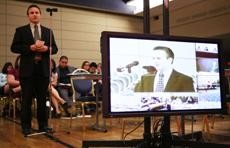Whether out of apathy or hopelessness, only a few students turned out to speak against next year’s proposed $1,100 tuition increase at the Arizona Board of Regents tuition hearing.
The controversy that many assumed would result in a mass student turnout stemmed from the now-ignored phrase in the Arizona constitution, which states that university tuition should be “”as nearly free as possible.”” The presidents of the three state universities have asked the Board of
Regents to remove the tuition cap, and therefore lift the Arizona schools’ tuition levels out of the bottom third of their peer group.
The forum, held Monday in the Student Union Memorial Center’s South Ballroom, was held because according to Arizona Board of
Regents requirements, a hearing must be held 10 days before any tuition changes are made so that there is an opportunity for opinions to be heard. The tuition hearing was teleconferenced from all three state universities so students could participate from multiple locations.
Because there will be no call to the audience at the regents meeting on April 30, the forum gave concerned voices an opportunity to be heard. However, the turnout at the event was fairly sparse.
UA President Robert Shelton explained via teleconference from Washington, D.C. that the surcharge would bridge the gap between budget shortfalls and the university’s needed revenue. He said though the surcharge is “”temporary”” and would have an annual review, the charge would be in effect until the budget level is restored to the Fiscal Year 2008 budget level.
Both Arizona State University
President Michael Crow and Northern Arizona University President John Haeger echoed President
Shelton’s address and asked the students to try and understand the desperation of the universities.
“”No one will be left behind for financial reasons,”” Crow said. “”We have made that promise before and we will make it again.””
President Haeger said NAU has lost over 100 staff members and have resorted to furloughs like the other universities. He said there is nothing else they can do but promise students that the quality of their education will not decrease.
“”We are asking them to bear some of the tuition burden. Our hope is that as we look at the next academic year and use the tuition increase surcharge and the federal stimulus dollars to move forward,”” Haeger said. “”What I would like to say is that … all three universities and presidents are asking for the surcharge for the students. We are asking for this for the students.””
Regents President Fred Boice said that he trusted the university presidents knew what they had to have financially in order to run their respective institutions, though he was impressed with the students.
“”I think the students did a really good job of presenting their case and it is one that my fellow regents can agree with,”” Boice said.
He said everybody could get along on a dollar less, including the students. He also pointed out that students could be better consumers and find alternative methods for finding aid.
“”I was listening to certain other students saying how they don’t have enough money and I wonder if they really had been good consumers, or if they had been to the financial aid office and pursued it,”” Boice said. “”Did they really get in there and ask what the university could do for them?””
Many students said that they were still holding up their end of the university-system bargain while the universities stopped considering their needs. Students from both the main campuses and the branch campuses of UA, NAU and ASU all tried to remind the university presidents and the board members that each university, especially the UA, made promises to the students ensuring the quality and affordability of the education they are working towards.
“”I have always been told ‘the harder you work the more you get.’ This is why I value higher education. When I was first here in fifth grade I knew I wanted to be a Wildcat,”” biology freshman Daniel
Hernandez said. “”It is getting very difficult, especially with two younger siblings to time out what will happen next. This is another increase that is coming out of not just people’s pockets, but the financial aid system. There was a promise of a predictability model here at the U of A and this would break that promise.””
Along with addressing the university representatives, students also tried to send messages to the Arizona state legislators. Arizona Student Association President Michael Slugocki stressed how unfortunate it was to have to address these issues, especially midyear.
According to Slugocki, the decisions and cuts the legislature has made have resulted in the proposal for economic surcharges. He said the ASA has maintained a “”resounding no”” against these surcharges.
“”None of us want to be here tonight. We are all brought here tonight because of the state legislature and clearly this situation is their fault,”” Slugocki said.
Associated Students of the University of Arizona President Tommy Bruce said that he was at the forum to support the ASA student proposal. He added that although it may seem as though it is an easy stance to take, students know that this is a conscious decision that will affect the quality of their education.
He said that the Board of Regents has to find a balance that allows support to go to all of the students at the university.
“”What we are asking is to wait eight months to the normal tuition setting in December. We need to learn more. We are asking for eight months to learn more so that all of the state university students have the opportunity to continue their education,”” Bruce said.









